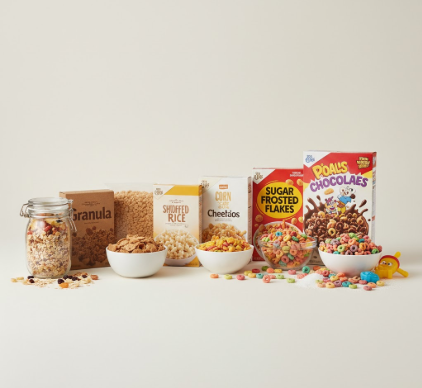Wander down the breakfast aisle of any supermarket today, and you are confronted by a riot of color, cartoon characters, and promises ranging from high fiber to marshmallowy delight. Breakfast cereal is a cultural staple, a quick morning fix for millions. Yet, its journey from a bland, health-focused innovation to the sugary, character-driven powerhouse it often represents today is a fascinating slice of food history, reflecting changing lifestyles, technological leaps, and marketing genius.
Believe it or not, the story of ready-to-eat breakfast cereal begins not with sugary cravings, but with digestive concerns and a push towards simpler, healthier living in the late 19th century. The era was marked by health reformers seeking alternatives to the heavy, often meat-laden breakfasts common at the time. Figures like Dr. John Harvey Kellogg, superintendent of the Battle Creek Sanitarium in Michigan, were central figures. He championed vegetarianism, exercise, and foods that were easy on the digestive system.
Working alongside his brother, Will Keith Kellogg, Dr. Kellogg experimented with various grains. Legend has it that a batch of boiled wheat left sitting out went stale, and when forced through rollers, it emerged as thin flakes. Toasting these flakes created a palatable, simple food. Initially called Granose, this accidental invention paved the way. C.W. Post, a former patient at the Sanitarium, was inspired by these ideas and soon launched his own competitor, Grape-Nuts (which, despite the name, contained neither grapes nor nuts, but rather wheat and barley), followed by Post Toasties, a corn flake rival.
The earliest breakfast cereals were developed with health and digestion as primary goals. Pioneers like Dr. John Harvey Kellogg aimed to provide easily digestible, grain-based alternatives to heavy traditional breakfasts. These initial products were far removed from the sweet concoctions that would later dominate the market. Their focus was entirely on perceived wellness benefits within the context of late 19th-century health movements.
These early cereals were promoted primarily for their supposed health benefits. They were seen as scientific, modern foods designed to promote regularity and overall well-being. Convenience was certainly a factor – they required no cooking – but the core message revolved around health and purity. The taste, by modern standards, was often secondary; texture and digestibility were paramount.
From Sanitarium Staple to Pantry Regular
The convenience factor, however, quickly became a major selling point as lifestyles began to change in the early 20th century. As more people moved to urban centers and work schedules became more regimented, the time available for preparing elaborate breakfasts shrank. Pouring cereal from a box into a bowl with milk was revolutionary in its simplicity. W.K. Kellogg, splitting from his more health-purist brother, recognized the broader market potential. He founded the Battle Creek Toasted Corn Flake Company (later the Kellogg Company) and began adding sugar to the flakes to improve their taste and broaden their appeal, much to his brother’s dismay.
This marked a subtle but significant shift. While health remained part of the marketing, palatability and convenience started gaining ground. Technological innovations further fueled the expansion. Processes like shredding (creating Shredded Wheat), puffing (like Kix or Cheerios), and extrusion allowed for an ever-wider variety of shapes, textures, and base grains. Cereals were no longer just flakes; they could be biscuits, Os, puffs, and more.
The Sweetening and the Selling: Targeting the Kids
The real transformation, however, kicked into high gear after World War II. The post-war economic boom, the rise of television, and the baby boom created a perfect storm for marketers. Cereal companies realized that children heavily influenced household purchasing decisions, especially regarding breakfast. The strategy shifted dramatically: make cereals sweeter, more colorful, and directly appeal to kids through advertising and packaging.
Sugar became a key ingredient, not just a light coating. Cereals like Sugar Pops, Sugar Smacks, Sugar Jets, and Frosted Flakes explicitly highlighted their sweetness. The health angle, while sometimes given lip service, took a backseat to fun, flavor, and excitement.
The Power of the Mascot and the Prize
This era saw the birth of iconic cereal mascots: Tony the Tiger, Cap’n Crunch, Toucan Sam, Snap, Crackle, and Pop (who actually debuted earlier but became central to kid-focused marketing later). These characters weren’t just on the box; they starred in animated television commercials aired during Saturday morning cartoons, directly pitching their sugary wares to young viewers. They became beloved figures, creating brand loyalty from a young age.
Another brilliant marketing tactic was the in-box prize. Small toys, games, decals, or trading cards hidden within the cereal box turned breakfast into a treasure hunt. Children pleaded with parents for specific brands, not just for the taste, but for the chance to get the latest prize. This strategy cemented cereals as a fun, kid-centric product, far removed from their austere, health-focused origins.
- Key Marketing Shifts:
- Heavy emphasis on added sugar and sweet flavors.
- Development of iconic cartoon mascots.
- Extensive television advertising targeting children.
- Inclusion of toys and prizes inside cereal boxes.
- Bright, colorful packaging designed to attract young eyes.
Navigating the Backlash and the Health Halo
By the late 20th and early 21st centuries, a counter-movement began to gain traction. Growing awareness of nutrition, concerns about childhood obesity, and criticism of high sugar content led to pressure on cereal manufacturers. The very tactics that had made cereals so successful with kids – the sugar, the cartoon characters, the prizes – came under scrutiny from parents, health organizations, and regulators.
The industry responded in several ways. Some brands subtly reduced sugar content or launched lower-sugar versions of popular kids’ cereals. There was a resurgence of interest in the “health” aspect, but this time focusing on different attributes: whole grains, fiber, added vitamins, and minerals. Cereals like Cheerios began prominently advertising their whole-grain oat content and potential heart health benefits (carefully worded to comply with regulations).
New brands emerged specifically targeting health-conscious adults, emphasizing natural ingredients, organic certifications, high fiber, or protein content. The cereal aisle became increasingly segmented, offering options across the spectrum: purely indulgent, sugary treats positioned right next to high-fiber, low-sugar alternatives aimed at adults seeking healthier choices.
The Cereal Aisle Today: A Complex Legacy
Today’s breakfast cereal landscape is a direct result of this long evolution. It reflects both the health-focused ideals of its founders and the powerful marketing engine that turned it into a kids’ phenomenon. You can find simple, minimally processed shredded wheat or bran flakes reminiscent of the early days, sitting alongside neon-colored loops bursting with artificial fruit flavors and marshmallows.
Fortification with vitamins and minerals is now standard practice across most brands, adding a “health halo” even to some of the sweeter options. The focus on convenience remains a primary driver. Despite challenges from other breakfast options like yogurt, breakfast bars, and smoothies, cereal holds its ground as a quick, easy, and relatively inexpensive morning meal.
The journey from Dr. Kellogg’s Granose to the vast array of modern cereals is more than just food history; it’s a reflection of shifts in dietary science (or at least perceptions of it), family dynamics, media influence, and marketing savvy. It’s a tale of how a simple attempt to aid digestion evolved into a multi-billion dollar industry that shaped the breakfasts, and perhaps the childhoods, of generations. Whether viewed as a health food, a convenient staple, or a sugary indulgence, breakfast cereal’s place on the table is undeniably baked into our cultural fabric.








